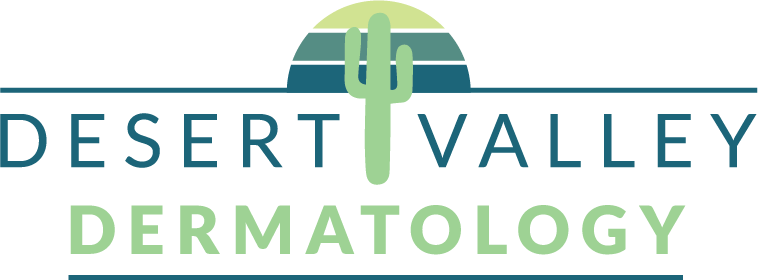Skin Cancer Treatment
At Desert Valley Dermatology, we perform comprehensive skin screenings to detect and treat skin cancers and non-cancerous growths.
Skin Cancer Prevention and Detection
At Desert Valley Dermatology, we believe that skin cancer prevention and screening are important parts of any wellness regimen. Skin cancer is the most common form of cancer in the United States, and it is estimated that one in five Americans will develop it at some point in their lives. We recommend that everyone protect their skin and detect skin cancer early.
We suggest seeking shade, wearing protective clothing, and using sunscreen with an SPF of 30 or higher to protect your skin from the sun. Always apply sunscreen approximately 15 minutes before going outdoors. When spending extended periods in the sun, reapply sunscreen every two hours.
We also recommend performing routine self-examinations and visiting your dermatologist regularly for skin cancer screenings. During a skin cancer screening, your doctor will perform a full-body exam to check for suspicious moles or lesions. They may also use specialized equipment to examine areas of concern in more detail.
If you have concerns about changes to your skin or abnormal growths, we can screen for the following types of skin cancer:
- Basal Cell Carcinoma
- Squamous Cell Carcinoma
- Melanoma
- Cutaneous T-Cell Lymphoma
- Merkel Cell Carcinoma
- Sebaceous Carcinoma
Additionally, we can identify non-cancerous skin abnormalities, including the following types of benign tumors:
- Dermatofibroma
- Hemangioma
- Keratinous and Pilar Cysts
- Lipoma
- Moles
- Seborrheic Keratosis
- Skin Tags
- Warts
Skin Biopsy
A skin biopsy is a medical procedure used to collect a sample of skin tissue for diagnostic testing. A skin biopsy is conducted to diagnose skin conditions, such as skin cancer or an infection.
The skin biopsy procedure is relatively simple and minimally invasive. The doctor will first clean the skin surface and then inject a local anesthetic to numb the area. Once the skin is numbed, the doctor will use a scalpel or small blade to remove a sample of skin tissue from the affected area. The sample of skin is typically no larger than a pencil eraser. After collecting the sample, the doctor will cover the area with a bandage to protect it.
A skin biopsy sample will be sent to a laboratory for testing. Depending on the results, additional therapies, such as surgical intervention or topical skin cancer treatment, may be recommended.
Skin Cancer Treatment Options
At Desert Valley Dermatology, our team of professionals provides the highest quality of care for the excision of skin cancers and abnormal moles. Our board-certified physicians have extensive experience performing these procedures and will provide you with the best possible treatment plan.
We offer the following treatments for skin cancers and suspicious growths:
Mohs Surgery
Mohs surgery is a specialized surgical technique for the removal of nonmelanoma skin cancers. The procedure involves removing thin layers of cancer-containing skin tissue, one layer at a time, and examining each layer under a microscope until all cancerous tissue has been removed. This is a tissue sparing technique used to address skin cancers that can be difficult to treat with other methods. The success rate of Mohs surgery is exceptionally high, with a cure rate of up to 99%.
Excision of Skin Cancers and Abnormal Moles
Excision of skin cancers and abnormal moles involves the removal of precancerous and cancerous lesions from the skin. Like Mohs surgery, this procedure is done in the office under local anesthesia and involves using a scalpel to remove the cancerous or abnormal tissue. Depending on the size and location of the cancerous or abnormal mole, the area may be stitched closed or left open.
Electrodesiccation and Curettage of Benign and Malignant Lesions
Excision of skin cancers and abnormal moles involves the removal of precancerous and cancerous lesions from the skin. Like Mohs surgery, this procedure is done in the office under local anesthesia and involves using a scalpel to remove the cancerous or abnormal tissue. Depending on the size and location of the cancerous or abnormal mole, the area may be stitched closed or left open.
Cryotherapy (Cryosurgery)
Cryotherapy can also sometimes be used to treat both non-melanoma skin cancers and pre-cancerous lesions. The liquid nitrogen used works by freezing and destroying the cancer cells while leaving surrounding healthy tissue unharmed. It is safe, minimally invasive, and can be used to treat superficial basal cell carcinomas and squamous cell carcinomas.
Topical Chemotherapy
Topical chemotherapy treatments including 5-fluorouracil and imiquimod are sometimes used for basal cell and squamous cell carcinomas. Typically, these can be used to treat very superficial skin cancers.
Desert Valley Dermatology: Advanced Skin Cancer Treatment in Phoenix
At Desert Valley Dermatology, we are committed to providing the highest quality care for our patients and helping them reduce their risk of skin cancer. We offer skin cancer prevention and screening tools and access to specialized skin cancer treatment. If you have any concerns or would like to schedule a consultation, please contact our helpful representative today.
